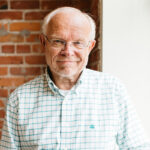We entered the lobby of Swedish Hospital carrying both a wavering uncertainty and a sober clarity about what this day would hold. Like Solomon in Ecclesiastes, our hearts were divided: is it a time for life or a time for death? Faith in the face of death asks us to hold both.
We knew what was waiting in room 316 in the ICU. Wendy’s sister, Terri, was about to be released from the chains of overwhelming pain. We knew that her life support would soon be removed. What we didn’t know was what the hours ahead would feel like—how heaven and earth might draw close in this sacred space.
There are liminal moments when the divine and the human meet—thresholds where eternity leans near. In an ICU room, faith is not just spoken in prayers and tears, but wrestled with in the quiet of one’s soul: What do I truly believe now?
Terri had already known deep sorrow. Just two years earlier, she had buried her youngest daughter, Katie. What, indeed, does our faith tell us about death when it collides with the ordinary rhythm of life? Perhaps she had an answer in a dream where she saw Katie as a young child, held with intense love by the arms of Jesus, and then, moments later, another vision of both Katie and Terri held in Jesus’ arms.
Crossing the Threshold of Life and Death
That Friday and Saturday, we faced what Paul calls, “The last enemy to be destroyed is death” (1 Corinthians 15:26). Death is an enemy, yes—but also an inevitability. It ends time and touch, conversations, and laughter, and brings separation and suffering. And yet, for the Christian, death’s sting is not final. It is the veil through which we pass into life everlasting.
That weekend, in the Intensive Care Unit, we declared our belief: grief is not the enemy. It is love’s shadow—its holy ache. “If I never loved, I never would have cried,”[1] sang Paul Simon, and he was right. To love is to risk loss. To lose is to risk grief. To grieve is to stand on holy ground.
Facing Death with Faith
I have been in rooms like this before, waiting for the inevitable, sometimes praying for the outcome we knew would never arrive. The ICU is many things:
- a battlefield, where some fight fiercely to live and others to keep someone alive;
- a courtroom, where families struggle over memories, regrets, and possessions;
- a portal to eternity, where angels keep silent watch;
- and always, a sanctuary of hope—an altar of belief, a holy space of story, memory, and legacy.
It is an ending—and also a beginning. For the Christian, it is never the end of the story. For some, death is the final step on a long pilgrimage of obedience, a victory march into the arms of Christ.
“For to me, living is Christ and dying is gain… my desire is to depart and be with Christ, for thatis far better.”
(Philippians 1:21, 23)
The Holy Work of Dying
In time, the morphine drip began. One by one, the machines sustaining her life were turned off. The hallway grew quiet. Lights dimmed. The noise of carts and voices faded. Terri was still lucid for a while. She whispered, “You’ve been too good to me.” I tried to argue, but she drifted into the sleep that waits for an ending. As I held her hand, I realized she was already beginning her journey toward eternity.
There were indignities—things that no one should have to endure—but they were met with grace by the nurses, those quiet saints of the ICU. The doctor came early, but it was the nurses—steady, compassionate, tireless—who became the hands of mercy. They adjusted oxygen, eased nausea, and watched over her with sacramental care. Dying is holy work, though not easy.
It was made easier by the tender care given by her daughter, who had thought ahead of favorite music, stories, and memories that brought us all the welcome comfort of laughter. One son was there with pictures of her great-grandchild, which stirred her own tender heart as did the words and prayer of an older son, present on FaceTime from Kansas City. The love shown by her children poured from hearts already grieving in a way that filled the room with a sweet and tender grace. As their uncle, I felt only great pride in each one.
When Time Stands Still
Time itself seemed to dissolve. No one hurried. We all waited in sacred stillness. Exhausted family members tried to sleep in chairs; one lay curled on the floor—my wife. Words were spoken softly. Hands were held tightly. The nurses called it “air hunger.” I thought of it as longing for the breath of God. Soon, we knew, she would inhale grace itself, not through a machine but in the pure, fresh air of Abba’s love. Even as we struggled to keep eyes open, she gave way to a morphine-induced sleep. Her hands stiffened and clutched our hands with an instinct for communion in her impending death. Blood flowed slowly as her body began to accept what it could no longer deny.
What had been ordinary was now transfigured.
- Sunday Seahawks games, once shared by phone between sisters, would now become sacred memories.
- Hope for recovery had long since turned into hope for redemption.
- In that room, surrounded by machines and monitors, hope took a different shape—it became the very air we breathed.
- For people of faith, hope is not a feeling; it is the pulse of resurrection life that whispers, “This is not the end.”

Her hand, now stiffening, instinctively clutched ours—communion in her dying. Her body trembled, then surrendered. Was she afraid? I cannot say. But we spoke words of promise and resurrection. We spoke of a place prepared for her by Jesus. We spoke of that which we cannot prove except by the belief in our hearts and souls grounded in Jesus’ promise:
“I am the resurrection and the life. Those who believe in me, even though they die, will live, and everyone who lives and believes in me will never die.” (John 11:25-26)
They say hearing is the last sense to fade. So, we filled the room with music, stories, memories, and Scripture—words that carried us beyond what could be seen. My wife, Wendy, talked as if her last remaining sister might answer, but certain she could hear. Tears came and went in waves. Laughter, too, because even at death’s door, joy finds its way in. We were not fooled by the finality of what we saw. We dared to believe that resurrection was drawing near.
Hope in the Air We Breathe
For people of faith, hope was the air we each breathed in that room, even as we waited death. Individually, we each knew the look, feel, and shape of our hope. Together, she saw dear Terri freed from her broken body, its failing and infected heart, its lungs no longer able to carry oxygen and sufficiently fill lungs without the need for a machine.
The moment, if we believed only what could be seen, was a moment of loss. Death waited to clutch her from us, his sister, daughter, sons, a brother-in-law, and son-in-law. But we fought this battle with prayers, tough tears, and laughter. The laughter of those who are not fooled by the limits of what we could see, but dared to look higher than a deathbed in the ICU. The moment of loss was interrupted by our hope for resurrection. The moment of loss was interrupted by each of our dreams for life on the other side, for her, because we each knew in the way you know what you cannot prove or ever see. The moment of resurrection was near.
And we began our individual steps to let her go. We had said goodbye; we had played the song she loved. We had laughed together, hugged each other as we shared our love for her. The long journey of our grief had begun.
Resurrection Was Already Beginning
When the time came, the nurses quietly confirmed what our hearts already knew—she was gone. Or rather, she had gone on ahead.
Wendell Berry’s Jayber Crow said it best:
“I saw that for me this country would always be populated with presences and absences, the living, and the dead. The world as it is would always remind me of the world that was, and of the world that is to come.”[2]
Then there was silence.
Machines turned off.
No alarms.
No rushing feet in the hall.
Only peace.
We prayed a final prayer of commendation, releasing her into the eternal mercy of God.
We had sung the songs she loved, laughed with her, and lamented with her. At one point, she had said with defiant humor, “This is ridiculous—I can’t even die right. Go home and sleep. I’m a mom who will not die!” And indeed, she did not die in spirit. She passed through death into life.
We worshiped with her. We worshiped for her.
Hope did not leave the room.
Because faith—the fierce, unrelenting kind that clings to Christ—remained with us all.
Even in the ICU, on a Friday night, resurrection was already beginning.
Practice: Sitting with Life and Death
Spend some time this week reflecting on a moment when you stood near the edge of life or death—perhaps at a bedside, a graveside, or in conversation with someone carrying deep loss.
Ask yourself:
- What did I learn about God, love, or faith in that space?
- Where did I sense resurrection hope, even in sorrow?
Then reach out to someone who is grieving, lonely, or caring for an aging loved one. Offer to simply sit with them—not to fix, but to listen.
Let your presence become a quiet prayer, your listening a sanctuary. Sometimes the most faithful act of spiritual friendship is not in the words we speak, but in the holy company we keep.
_______________________

Keith Anderson, D.Min., is a Faculty Associate for Spirituality and Vocation at VantagePoint3 and President Emeritus of Seattle School of Theology and Psychology. He is the author of several books, including his most recent: On Holy Ground: Your Story of Identity, Belonging and Sacred Purpose (Wipf & Stock, 2024). His other works include Reading Your Life’s Story (IVP, 2016), A Spirituality of Listening (IVP, 2016), and Spiritual Mentoring (IVP, 1999). In his writing, teaching, and mentoring, Keith seeks to set a table for people looking to enter the “amazing inner sanctuary of the soul” in the most ordinary and extraordinary moments of life.
[1] Paul Simon, “I am a rock”
[2] Wendell Berry, Jayber Crow, p. 132


3 Comments
Thank you for this! What a blessing of hope for a time of grief.
Thank you, David. I’ve been reading a book this year by Francis Weller, a Jungian therapist called The Wild Edge of Sorrow. He reminded us that grief work is essentially soul work, not a problem to be solved or a condition to be medicated. Bringing grief and death out of the shadow is our sacred duty. I think Wendy and I did that in the ICU. What I know is that this is hard and painful work and I know our faith is the door we open to that “blessing of hope” you talked about. Keith
Thank you, Keith.